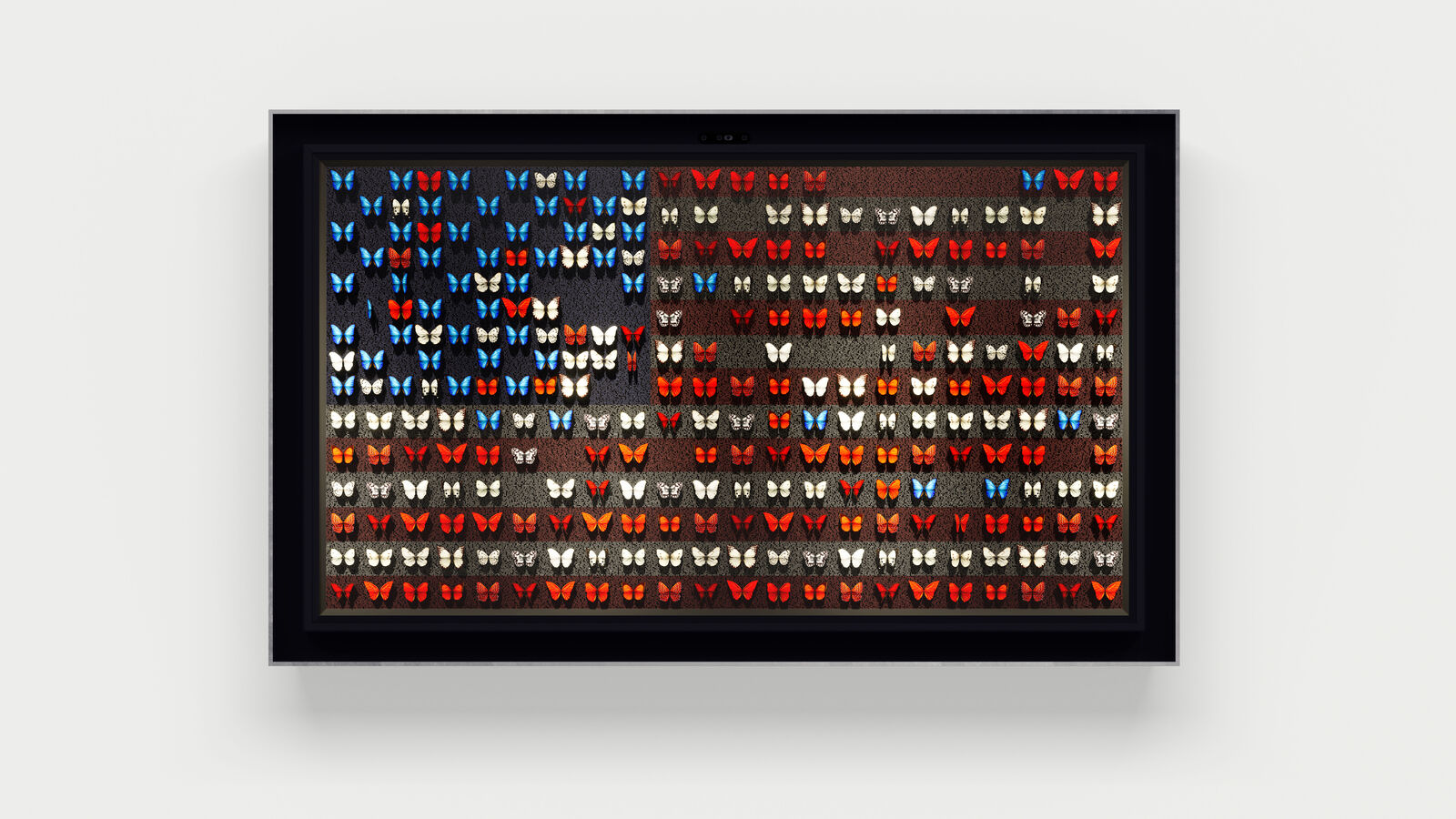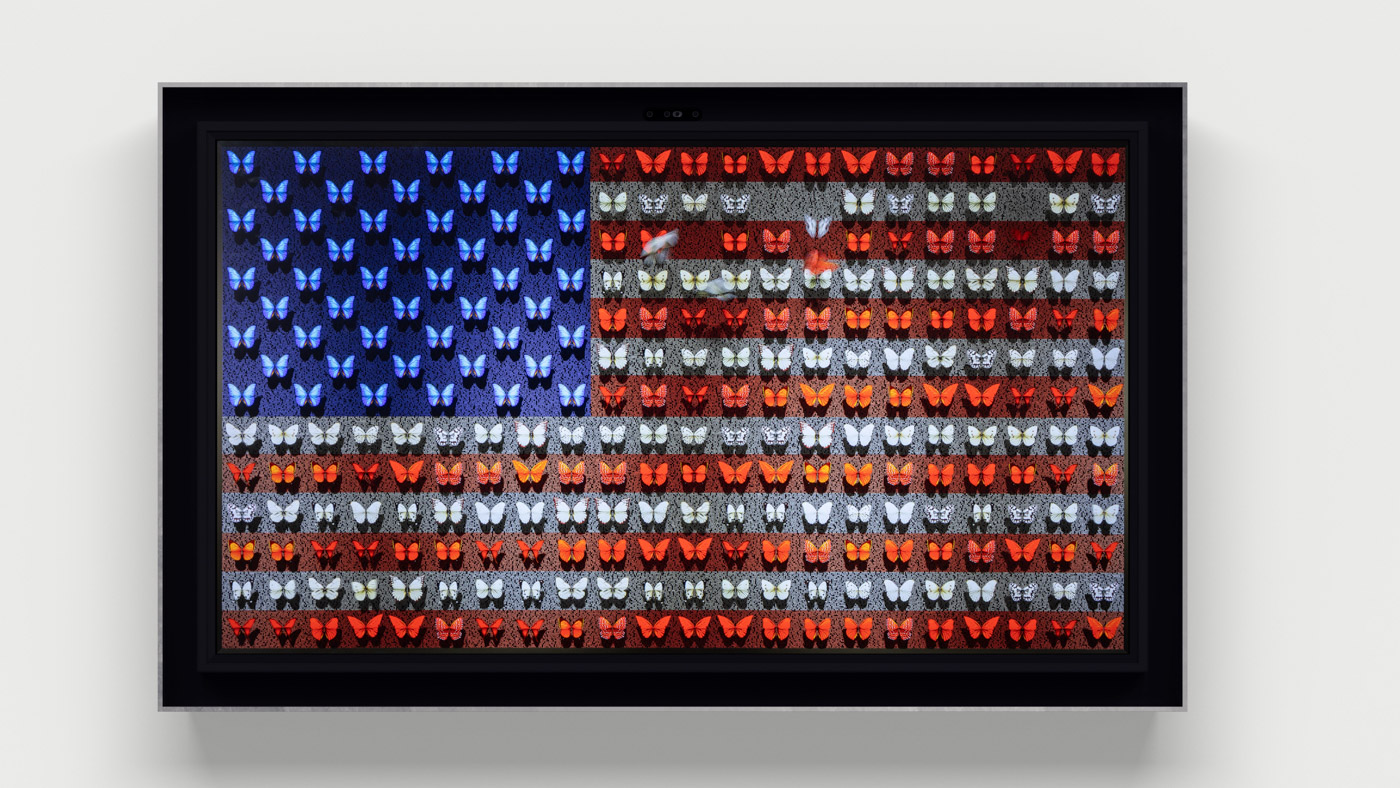 ⤣ SERIES
⤣ SERIESSounds Of Liberty
Sounds of Liberty presents a real-time American flag composed of animated butterflies, each responsive to human touch. When a butterfly is touched, it speaks a current news headline sourced live from the internet, while the background—seemingly a wash of colour—reveals scrolling lines of microtext: full-length journalism stories linked to the spoken fragment. As the butterflies scatter and reform, the flag’s structure shifts, reflecting how collective identity is shaped and disrupted by the way we engage with information.
The work contrasts the immediacy of the spoken headline with the depth of its buried source—the full news article, which scrolls as nearly invisible microtext in the background. As the butterflies scatter and reform, the flag’s structure is held in a constant state of flux, mirroring how collective identity is shaped and disrupted by our engagement with information. Accompanied by a haunting, original score based on The Star-Spangled Banner, the piece is intended as a profound meditation on perception, truth, and the evolving sound of liberty in a data-saturated age.
The Collection
Images
Information
Year:
2025
Edition:
Edition of 8 + 2 Artist Proofs + 2 Museum Proofs
Materials:
Code, Electronics, 4K Touch Display, Sound System, Computer, Sensors, Steel, Aluminium
Details:
Music Composition: Dougal Drummond and Kristian Gilroy
Dimensions (Metric):
Large Format (85 inch) including frame:
213 x 130 x 21 cm
(W x H x D)
Dimensions (imperial):
Large Format (85 inch) including frame:
83.9 x 51.2 x 8.3 inches
(W x H x D)
Commissioned by:
Context
Sounds of Liberty enters a rich and contentious art-historical dialogue where artists have appropriated the American flag to interrogate national identity. The work positions itself in a lineage that includes Jasper Johns, who famously chose the flag as a design "the mind already knows" to explore the boundary between object and symbol, and David Hammons, whose African-American Flag (1990) powerfully re-contextualized the icon to assert a distinct cultural identity. Art historian Joachim Pissarro notes that by using this motif, Harris is placed "in the company of historical and contemporary artists who have turned to flags in their art". However, where artists like Dread Scott used physical participation to create a platform for dissent,
Sounds of Liberty updates this tradition for the digital age, arguing that the primary threat to the symbol's integrity is now informational, driven by the very media through which modern identity is constructed and contested.
The work's most urgent theme is its direct engagement with the contemporary "post-truth" condition, defined as an environment where "objective facts are less influential in shaping public opinion than appeals to emotion and personal belief". The artwork functions as a live model of this phenomenon: the viewer's touch triggers an audible, emotionally charged headline, while the corresponding in-depth journalism scrolls by as nearly illegible microtext. This mechanic makes the viewer an active agent in the fragmentation of the symbol, a process Pissarro describes as conjuring "up a sense of our culpability, and even fear, in front of this cycle of creation and destruction, all the more so, as we, viewers, are the ones who come to disrupt the flag from its pristine perfection". The artwork thus moves beyond mere critique to implicate the audience in the very system of high-speed, low-context information consumption that defines our era.
Sounds of Liberty also represents a pivotal evolution within Dominic Harris's own practice. Building on his earlier World Stage series, which first used butterfly swarms to construct national flags, this piece deepens the conceptual stakes by integrating live data feeds and AI-generated audio. This technological layering transforms a general meditation on identity into a specific and trenchant critique of our media landscape. As art historian Catherine Mason states, Harris is a digital artist who "masterfully blends technology, interactivity, and the sublime to create immersive experiences that redefine the boundaries of art". By applying his signature butterfly motif—a long-standing symbol of transformation and fragility in his work—to the American flag and infusing it with the chaotic data of the present moment, Harris creates his most politically resonant work to date, one that questions the very nature of truth, unity, and patriotism in a digitally saturated world.


















